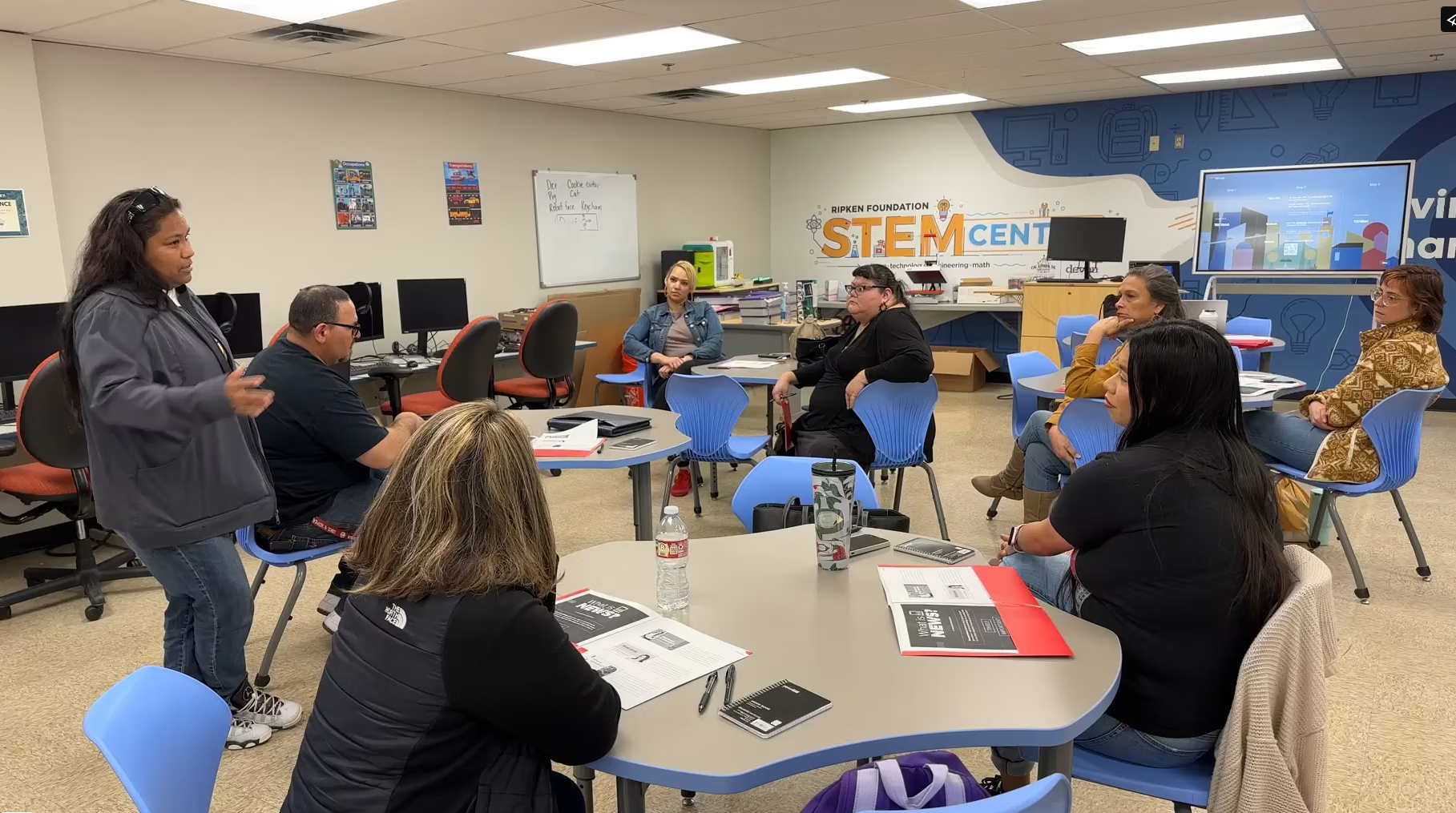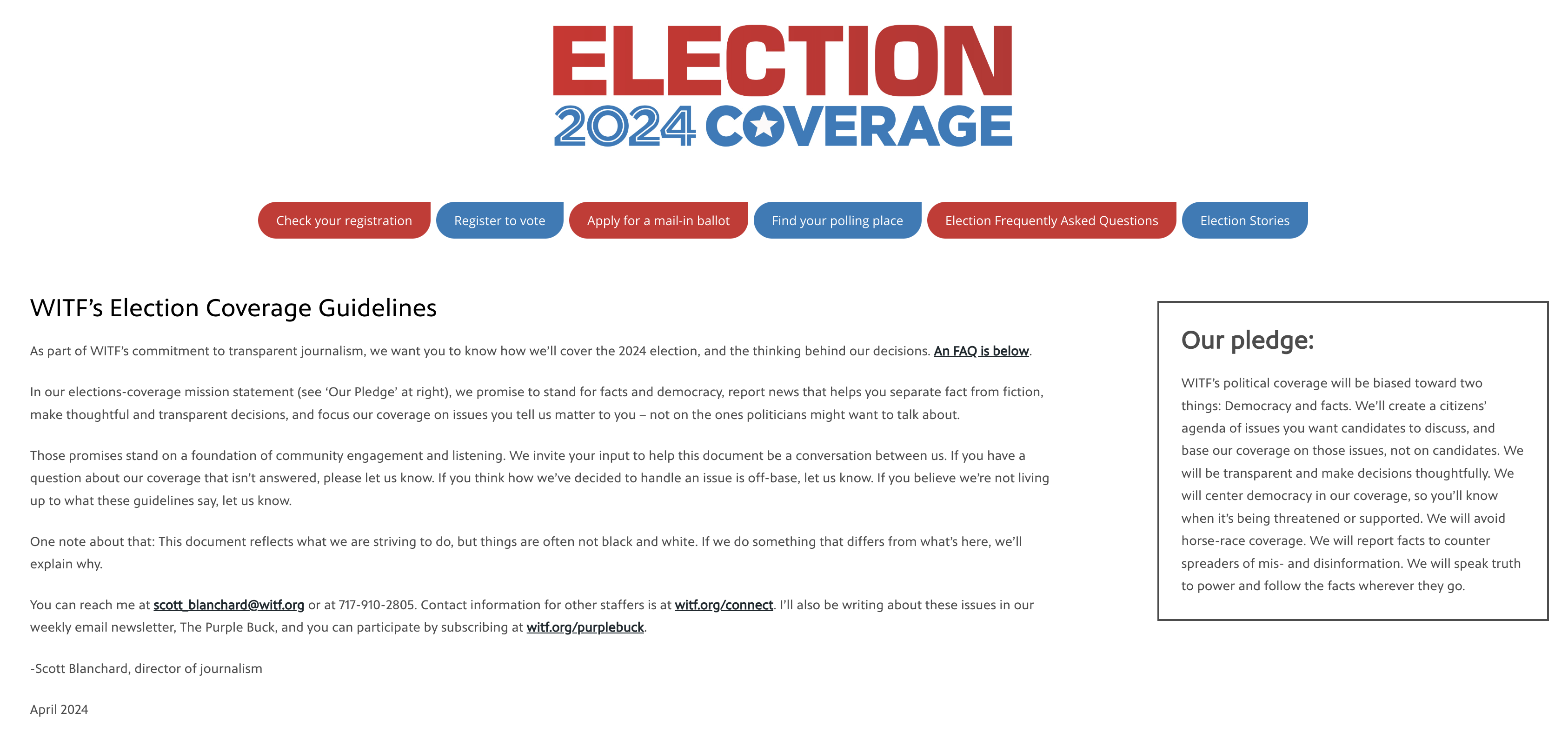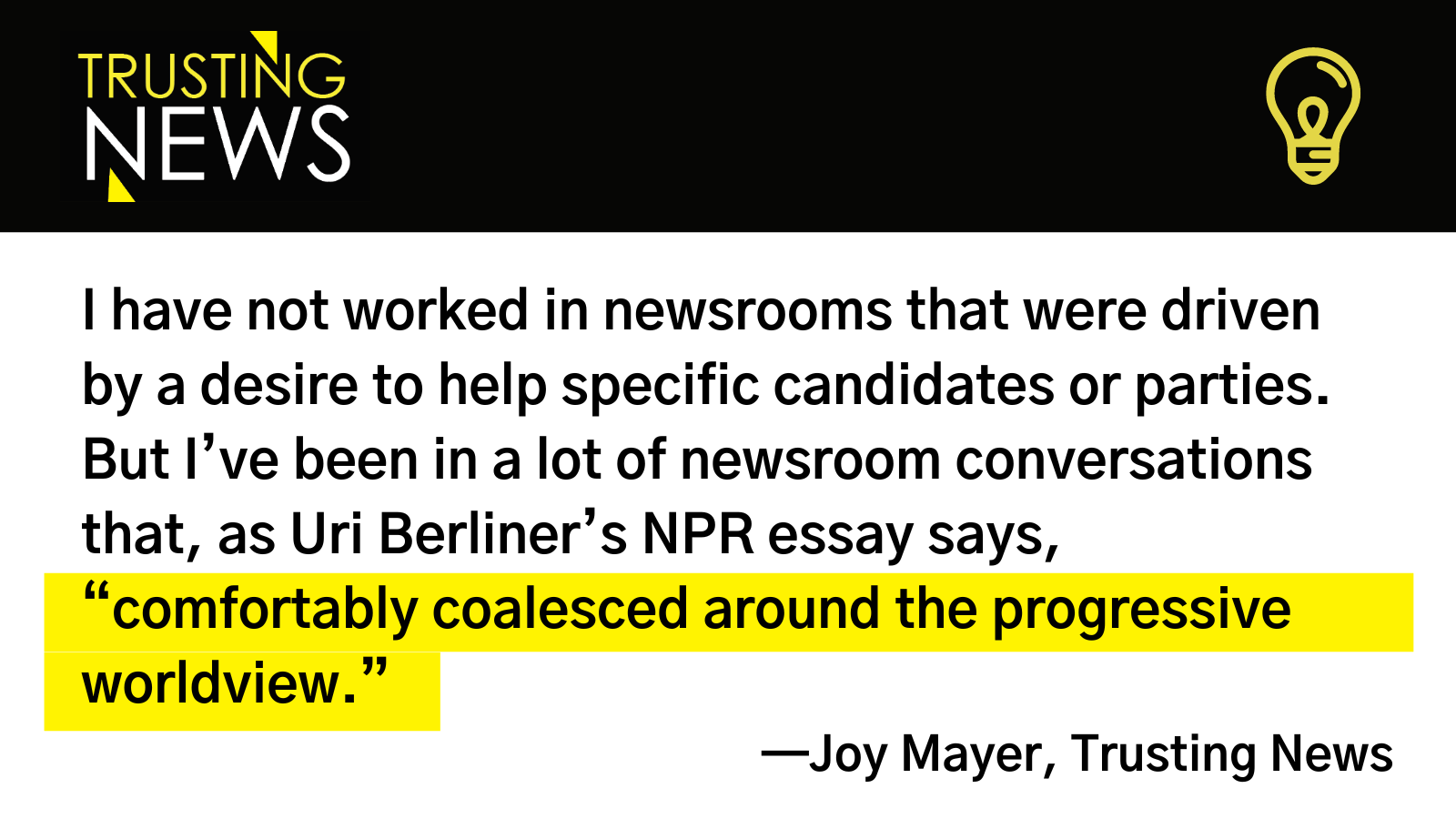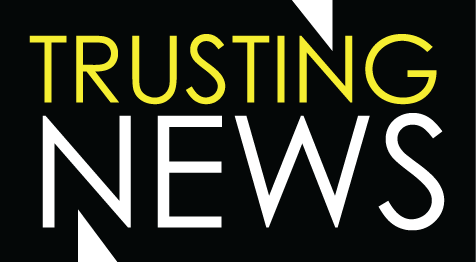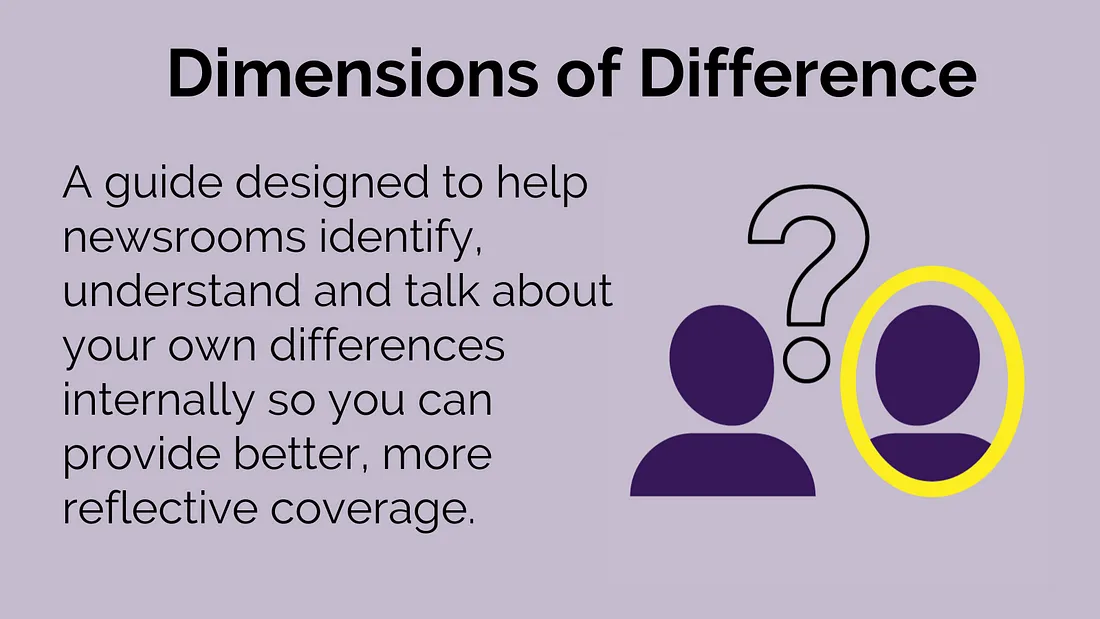
Journalists, we have to stop assuming people understand the mission, ethics and processes behind our work. We can’t let ourselves get lumped in with perceptions of “the media.” Instead, we need to actively work to ear
Workshop helps journalists celebrate and understand their differences
If newsrooms want to build trust, they have to work to better understand and reflect the community they serve. This work involves listening and engagement, increasing the diversity in newsrooms and having conversations about who is currently represented in newsrooms.
In the last year, Trusting News and Spaceship Media have partnered to develop and launch Dimensions of Difference — a program designed to support newsrooms in creating better content by helping them identify, understand and talk about their differences internally. The program helps them understand how their own values, perspectives and assumptions show up in their work and how they can have productive conversations in the newsroom in order to create more accurate, reflective coverage of their complex communities.
For our initial workshop, we were lucky to have Dr. Sue Robinson leading an analysis of the work. That analysis validated the transformational power of helping journalists talk about how their own values and experiences shape their journalism.
We’re always grateful when researchers help us assess the impact of our work — especially when we’re experimenting with new ideas and strategies.
— Joy Mayer, Trusting News Director
How six newsrooms explored their Dimensions of Difference in staff
By Sue Robinson, University of Wisconsin-Madison
When one senior journalist hosted an informal conversation with his coworkers recently, he was startled to realize that he didn’t really know them at all — and as a result, wasn’t fully utilizing all the expertise available already in his newsroom.
“We used to have biweekly happy-hour meetings, which were more personal, but we stopped,” he told us in an interview, referring to the changes the pandemic had wrought. “So … I said, wow, I don’t know that much about my colleagues.”
This journalist participated in a five-session series of workshops called Dimensions of Difference, hosted and organized by Eve Pearlman of Spaceship Media and Joy Mayer of Trusting News and funded by New Pluralists. I and my research team at the University of Wisconsin-Madison evaluated the Dimensions program last year.
The training asked participating journalists to interrogate their own values, views and experiences in relation to their journalism and to develop newsroom action plans to support more inclusivity at work as well as in their communities. The training structure is based on the Dimensions of Difference Newsroom Guide, which walks journalists through activities and conversations about journalists’ own individual values and views, the newsroom ideals, the make-up and backgrounds of the communities those journalists serve, and newsroom dialogues about all of it.
“We all come from somewhere: a family, a place, an era, a religion (or not), a political ideology, a set of evolving values and ideas. Who we are informs our journalism — including what we notice as well as what we miss,” Pearlman said. “Identifying, understanding and talking about our differences improves our coverage, our accuracy, our relevance, and our ability to serve the public.”
Mayer added that in the workshop, Dimensions trainers asked participating journalists to identify and practice talking about their own differences as they relate to specific coverage. She said, “We explored how we can strengthen our journalism by bringing deeper awareness, honesty and stronger communication skills to discussions about our complex and multifaceted identities and experiences.”
In this post, I detail the outcomes we observed after six newsrooms with 16 journalists participated in a pilot Dimensions of Difference program, and what we learned from the guide that served as a foundation for the training.
The impact, gathered through interviews, focus groups and surveys from the participating journalists, were nothing short of transformative: Participants came away with more awareness of the complexity of forces at work in their news, more awareness of cultural differences, greater appreciation of colleagues, more acknowledgment of how their values, views and ideals impact their reporting practices, and more inclusion of different perspectives in both the newsroom and communities.
In other words, the Dimensions of Difference workshops provoked better journalism.
The Concepts Behind Dimensions of Difference
In the 28-page guide and throughout the 5-week training, the concepts behind Dimensions of Difference provide a holistic framework for approaching all the various components of news work.
First, journalists are encouraged to focus on their own identities (thought of broadly, from being a parent to being a veteran or even a pet owner) and the values that drive their behavior (integrity, compassion, etc.).
Second, the program emphasizes a thorough exploration of the newsroom’s own diversities, and how well they align with the people working in it and their lived experiences. Does the culture allow all voices to be heard, even if they might be considered contrary?
Third — and this may seem obvious — journalists must consider who is in their communities. This focuses not just on demographics, but also questions about its cultures as well as who in the newsroom reflect the place itself.
Fourth, the program turns the spotlight on the journalism content, asking editors and reporters to audit their own work for perspectives and source diversity, for example, and then set up a plan to interrogate their content through tricky newsroom conversations.
In the final segment, newsrooms are asked to begin internal conversations, guided by specific questions meant to disrupt ignorance or status-quo values that may be leading to problematic coverage.
Who is in your newsroom?
Participating newsrooms were asked to create individual plans to take back to their colleagues, building on the Dimensions concepts. About half of the participating journalists decided to focus on internal newsroom differences by conducting a series of conversations within editorial divisions. One journalist told us they “try to do as many as we can, sometimes even once a week, brainstorming sessions on issues. Different editors lead … It’s half an hour. Everybody participates.” The result? A broader range of story ideas, story sources, and story angles, he said.
In addition, the guide encourages managers and reporters to respect the different relationships people have to their job as well as the different life priorities and values that influence their work. As one example of this last task, one editor told us that he used to pass judgment on reporters who did not commit fully to the job as their only priority. Now, he says, he appreciates that having outside interests brings important perspectives to the work.
“Now, it’s different. I say, ‘This person has really good skills and can do a lot of things that we need here’,” he said, “and I know that if I get that person for two, three years, that’s good, without that judgment.”
Across the board, participants reported widespread evolutions in the way they were thinking about stories, word choice, sources, beats, headlines, and also… each other. They reported being more deliberate in the decisions that they used to make on the fly.
One participant told us in an interview that the trainings were helpful to think more fully about what “diversity” looked like in their coverage, including thinking about reporters’ own identities.
“There’s a lot of talk about ‘It’s okay to … not be objective and that if you are a Black woman, for example, that [identity] informs your reporting and that’s okay,” she said. “But I think we’ve mostly only been thinking about it in an empowering way and not how that affects the coverage and invites or discourages people from actually reading the work,” she continued. “So this idea of really examining your own values, assumptions, biases, and seeing how that affects the outcomes with the end goal of making sure that we have journalism that is inclusive rather than exclusive, is something that I think is really important.”
Another participant told us in an interview that she’d struggled in the past to constructively raise concerns about her newsroom’s coverage, and the workshops gave her the language and strategies to frame the conversations in her newsroom so that it would be more constructive and not merely, “something about this story made me upset.”
In another example of how mindsets were changing, two journalists from the same newsroom noted that since the exercises, they watched for tone and word choice in all their own news consumption and were more careful in their own writing. The participants described how the internal conversations prompted them to pause in the positioning of a negative Trump story:
Journalist One: Actually there was a conversation recently between me and [Journalist Three] in a meeting where I was like, “Why wouldn’t we put this story on the front page?” And I can’t remember what the story was, but it was sort of a negative-
Journalist Three: A Trump development.
Journalist One: It was a Trump development that wasn’t good for Trump. And [Journalist Three] was like, “Well, I can hear [Journalist Four].” Who is one of our editors and a two-time Trump voter. He was like, “I can hear [Journalist Four] in the back of my head.” Remember that conversation?
Journalist Three: Yeah.
Journalist Two: So I think we do talk about this type of stuff.
We heard many anecdotes such as this, where journalists’ understanding of the dimensions of difference around them helped eke out outcomes less polarizing. And finally, they reported more internal cohesion and the implementation of more reporter and all-newsroom check-ins to ensure a workspace friendly to difference and pushback.
Bringing “Difference” into communities
Opening up about differences in newsrooms carried over into work rebuilding trust among different community groups, including doing internal audits for sources in stories, conducting reader surveys, and hosting listening sessions with disengaged audience members. Through the Dimensions of Difference training, participating journalists found ways to confront tensions with publics who had unrealistic expectations for journalists.
“We want to be inclusive of conservative readers, but some of our conservative readers are mad because we’re not publishing conspiracy theories. We’re not going to do that, obviously,” said one editor. “So I felt like it was very helpful in terms of helping us navigate what is the fair thing to do versus the pandering thing to do.”
This was a key dynamic for all of our participants: In one story-analysis workshop, the participants examined a story about a city mayor spending taxpayer money to travel to a sister city in France. As they debated whether the story should have run or whether it was too “snarky” in tone, one participant pointed out that the mayor was African American, and would they see the same kind of framing for a white mayor? That comment made the group pause and re-analyze the story.
One of the newsrooms published an op-ed reader survey, targeting Spanish speakers to get a sense of how their editorial pages could better serve that constituency. Another used the philosophy undergirding Dimensions of Difference to work on a “Right to be Forgotten” policy to selectively unpublish or modify old coverage. Another made it a point to reach out to right-leaning voters in their mostly liberal community to highlight “less crazy voices in the room.” Still others are conducting story audits to track source diversity and gauge for any bias.
Seeing “Dimensions” as good
Participating journalists reported many challenges in doing the work of engaging with difference, including: intractable “traditional” mindsets and culture from top management or veteran reporters, generational conflicts around social justice topics, feelings of nervousness about really getting to know colleagues (what if they discovered someone was an election denier?) as well as money and time constraints.
For example, one editor noted the constant friction between old-school and younger journalists in terms of their approaches to social justice reporting and the concept of objectivity. At first, she said, “You think ‘Wow, we really see journalism differently.’”
She added, “So how do you help share what you think has value while also not being on a soapbox and also learning from them that there’s, ‘Okay, journalism can change and evolve and I need to listen and appreciate their point of view’.”
What the Dimensions of Difference trainers, Trusting News and Spaceship Media, are really training these journalists in is how to strategize disruption of the status quo in all kinds of newsrooms, from large legacy outlets to public radio to smaller community papers. Disruption to traditional practices. Disruption to changing habits entrenched in the newsroom. Disruption to established institutions through different kinds of stories and sources.
The Dimensions of Difference training helps journalists laser in on their fundamental core and their value systems at a critical juncture in the profession’s history. Ultimately, the conclusion of our evaluation underscored how valuable this training has been and the difference it has made in the lives of the participants. As one reporter who underwent the training said, the Dimensions work with Trusting News and Spaceship Media “has helped me become a more empathetic journalist. I would find it impossible to believe that there isn’t a newsroom and/or beat that exists that wouldn’t benefit from this training.”
At Trusting News, we learn how people decide what news to trust and turn that knowledge into actionable strategies for journalists. We train and empower journalists to take responsibility for demonstrating credibility and actively earning trust through transparency and engagement. Subscribe to our Trust Tips newsletter. Follow us on Twitter andLinkedIn. Read more about our work at TrustingNews.org.
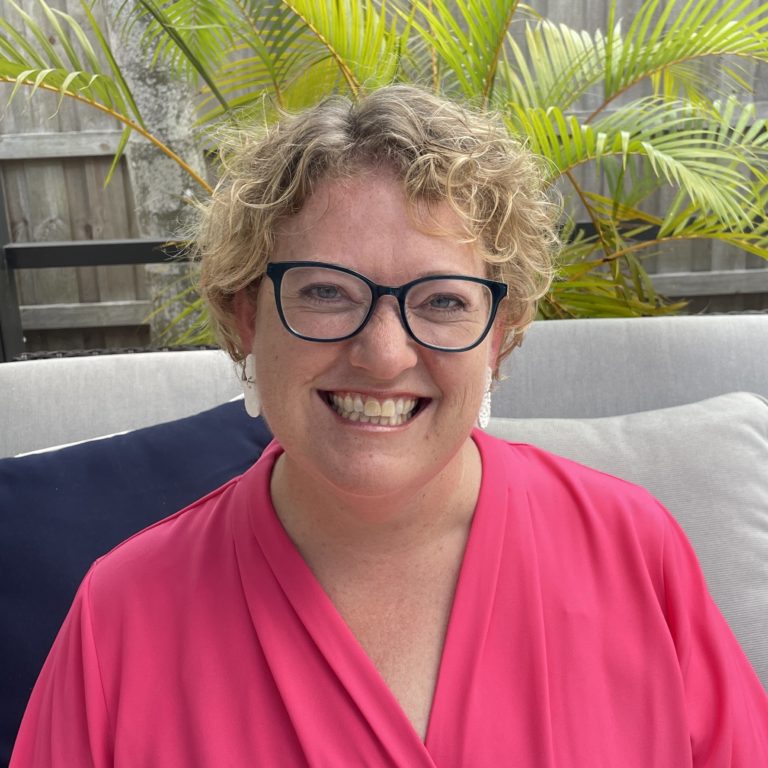
Director Joy Mayer (she/her) founded Trusting News in 2016 after a 20-year career in newsrooms and teaching. She spent 12 years at the Missouri School of Journalism, where she created an audience engagement curriculum and a community outreach team in the newsroom of the Columbia Missourian and also taught web design and print design. She lives in Sarasota, Florida, and can be reached at joy@TrustingNews.org or on Twitter @mayerjoy.
